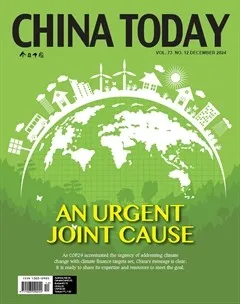A Fundamental Approach



To overcome resource constraints, China sets quantitative goals for green transition.
THIS year marks the 30th anniversary of theUnited Nations Framework Conventionon Climate Change (UNFCCC) and theninth anniversary of the Paris Agreement.Prior to the 29th session of the Conference of theParties to the UNFCCC (COP29), the sixth Friendsof the Paris Agreement High-Level Dialogue,organized by the European Climate Foundationin Paris, France in late October, and co-hosted bythe Institute of Climate Change and SustainableDevelopment of Tsinghua University, brought togetherthose who had participated in or witnessedthe process of reaching the Paris Agreement. They reviewed the global response to climate changein the past, the achievements made, the currentsituation, and the key tasks. The conclusion at thedialogue was presented at the COP29 conferenceand the UNFCCC secretariat.
I was honored to attend the dialogue with XieZhenhua, China’s former special envoy for climatechange, and gained a deeper understanding of thework to combat climate change.
In recent years, the earth has been warming upat an unprecedented speed due to the increase inhuman-induced greenhouse gas emissions. Researchby the Intergovernmental Panel on ClimateChange shows that human activities have causedrapid, extensive changes in the atmosphere,oceans, cryosphere and biosphere. A World MeteorologicalOrganization report says 2023 was thehottest year on record, registering a global averagetemperature that was 1.45°C higher than the preindustriallevel.
Climate change is affecting every region, posinga serious threat to human survival. A study bythe World Health Organization points out that itis the greatest threat to human health. We need toreverse this situation not only to save the earth'secosystem but ourselves.。
The Paris Agreement is the broadest internationalconsensus on climate change and points outthe direction and institutional arrangements forglobal efforts to address the issue. These efforts arenow facing many difficulties and challenges, giventhe stark contrast between where we are and wherewe aim to be. The setbacks to global green transition,politicization of environmental and climateissues, barriers to green trade, and uncertainties ininternational cooperation are of particular concern.
To address climate change China has acceleratedenergy transition at home. At the same time, itis serving as a key stabilizing force for internationalendeavors for this mission. In August, the Chinesegovernment made new strategic arrangementsto promote green transition of the economy andsociety.
Goals and Challenges
Over the past 30 years, especially the nine yearssince the Paris Agreement went into effect, thegoals and approach of global climate governancehave become increasingly clear. The UNFCCC’sultimate objective is “to achieve, in accordancewith the relevant provisions of the Convention,stabilization of greenhouse gas concentrations inthe atmosphere at a level that would prevent dangerousanthropogenic interference with the climatesystem.”。
It also establishes the principle that the “Partiesshould protect the climate system for the benefitof present and future generations of humankind,on the basis of equity and in accordance with theircommon but differentiated responsibilities andrespective capabilities.”。
The Kyoto Protocol, adopted in 1997, prescribes mechanism for burden sharing among developedcountries. The Paris Agreement planned for actionsto address climate change after 2020. It introducedthe innovative practice of “nationally determinedcontributions,” which means participating countrieswill make differentiated contributions according totheir respective national conditions, developmentstages, and capabilities, to tackle the challengesbrought about by climate change. It also stipulatedthat the Conference of the Parties would undertakeits first global stocktake (GST) in 2023 and every fiveyears thereafter.
The first GST in 2023 disclosed a huge gap betweenactual actions and the goals and commitments.There were shortfalls in technology, funding,and transparency, especially in the speed and scale of financing. The United Nations EnvironmentProgramme estimated that by 2030, the fundingneeds of developing countries for climate changeadaptation will soar to US $340 billion per year, yetless than one-tenth of the amount is available now.Many developing countries have limited access topublic financial resources and are weak at raisingfunds on the capital market. These factors hampertheir ability to implement strong mitigation andadaptation measures.
At the same time, unilateralism and geopoliticaldisputes have severely impacted the multilateralcooperation system for addressing climate change.To achieve the Paris Agreement goal of confiningthe global average temperature increase to wellbelow 2°C above pre-industrial levels and pursuing to limit the temperature increase to 1.5 °C abovepre-industrial levels, all parties must adhere tomultilateralism, continue climate governance andcooperation under the agreement’s framework, andstrengthen exchange and consultation. Unilateraltrade measures will slow down green transition.Also, developing countries should be funded tosupport stronger actions.
China’s Contributions
As the world's largest developing country,China has taken a series of measures to addressclimate change. In 2020, China announced thatit would scale up its intended nationally determinedcontributions, peak CO2 emissions before2030, and achieve carbon neutrality before 2060.For this purpose, it has stepped up the developmentof renewable energy to control carbondioxide emissions.
These efforts have produced encouraging results.By September this year, China's installed capacityof wind and photovoltaic power totaled 1.25 billionkilowatts, fulfilling its promise to increase thiscapacity to 1.2 billion kilowatts by 2030 six yearsahead of schedule. So far, there are over 25 millionunits of new-energy vehicles (NEVs) plying in Chinaand in the first 10 months of this year, NEV salestopped 9.8 million, accounting for 38.6 percent oftotal new car sales during this period.
China is building up its strength in the newenergy industry with technological innovations,creating complete industrial and supply chains,encouraging market competition, and tapping intoits super-large market. Its new energy industryis growing fast, with a clear competitive edge inphotovoltaic products, lithium batteries, and NEVs.This has significantly brought down the costsof wind power, photovoltaic power, and electricvehicles worldwide. China is exporting wind powerand photovoltaic products to more than 200 countriesand regions, contributing to the wider use ofrenewable energy and global energy transition.
The Way Ahead
This August, the Chinese government issued aset of guidelines on green transition in all areas ofeconomic and social development to coordinate itsefforts in carbon reduction, pollution control, green expansion and economic growth for peaking emissionsand achieving carbon neutrality.
China regards green, low-carbon transition asthe fundamental approach to resolving resourceconstraints and enhance energy security. Energy isan important basis for economic and social development,but it is also the main source of carbonemissions, accounting for more than 80 percent ofall carbon dioxide emissions on earth. To tackle thisproblem, quantitative goals have been set, such asincreasing the share of non-fossil energy consumptionto about 25 percent and lifting the installedcapacity of pumped-storage hydropower projects toover 120 million kilowatts by 2030.
Energy conservation and carbon reduction arebeing promoted in key sectors to buttress greentransition. Since 2013, China has attained an averageannual economic growth of 6.1 percent with anannual 3.3 percent increase inits energy consumption. And itsenergy intensity has decreasedby 26.1 percent, one of thesteepest drops worldwide. By2030, China aims to expand itsenergy conservation and environmentalprotection industriesto RMB 15 trillion.
Sustained and rapid growthof green and low-carbon industriesis being maintained as thedriver of high-quality economicdevelopment. Green development is the foundationof high-quality development, and the new qualityproductive force, which has become a buzzword, isa green productive force.
Green and low-carbon industries will be developedand their share in the national economyincreased. New industries, new business forms,and new business models that facilitate green, lowcarbondevelopment are being encouraged. China'sfirm commitment to green development will givemore stability to the global response to climatechange, and the innovative development of its newenergy industry will provide greater impetus forsustainable development around the world.
Lü WENBIN is head of the Energy Research Institute of NationalDevelopment and Reform Commission.

